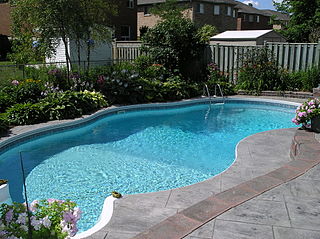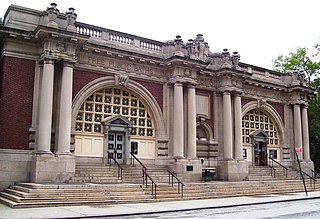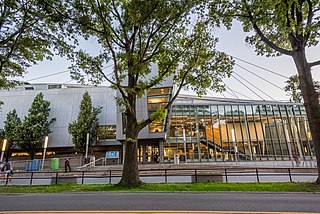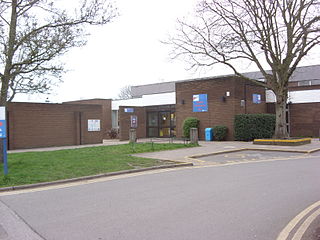
South Bend is a city in and the county seat of St. Joseph County, Indiana, United States, on the St. Joseph River near its southernmost bend, from which it derives its name. At the 2020 census, the city had a total of 103,453 residents and is the fourth-largest city in Indiana. Located just south of the border with Michigan, South Bend anchors the Michiana region and is 72 miles (116 km) east of downtown Chicago. The metropolitan area had a population of 324,501 in 2020, while its combined statistical area had 812,199.

Indiana University South Bend is a public university in South Bend, Indiana. It is the third largest and northernmost campus of Indiana University.

The Payne Whitney Gymnasium is the gymnasium of Yale University in New Haven, Connecticut. One of the largest athletic facilities ever built, its twelve acres of interior space include a nine-story tower containing a third-floor swimming pool, fencing facilities, and a polo practice room. The building houses the facilities of many varsity teams at Yale, including basketball, fencing, gymnastics, squash, swimming, and volleyball. It is the second-largest gym in the world by cubic feet.

Lambert Fieldhouse is an athletic facility on the campus of Purdue University in West Lafayette, Indiana. It was built in 1937 on land bought by David Ross and George Ade as a replacement for Memorial Gymnasium to be the home of the Purdue basketball team, and also contained an indoor track. Memorial Gym was a 2,000 seat facility built in 1910 which had outgrown its usefulness, as the team had even resorted to playing games at the local high school gym, which seated twice as many as the gym did. In 1967, the team moved into the newly built Mackey Arena next door, and the building was remodeled to become a full-time track facility. The building also contains pool facilities, which were in use by the swimming and diving teams until 2001, when the Boilermaker Aquatic Center was completed.

The Gerald Ratner Athletics Center is a $51 million athletics facility within the University of Chicago campus in the Hyde Park community area on the South Side of Chicago, Illinois in the United States. The building was named after University of Chicago alumnus, Gerald Ratner. The architect of this suspension structure that is supported by masts, cables and counterweights was César Pelli, who is best known as the architect of the Petronas Towers.

Indiana University Natatorium is a swimming complex on the Indiana University-Purdue University Indianapolis campus in Indianapolis, Indiana, United States. It also serves as the home of the IUPUI School of Health & Human Sciences with its offices on the second level and the Polaris Fitness Center on the first level. The Human Performance Lab is housed in the basement of the Natatorium building.
The United States Spring Swimming Championships are held annually in the spring since 1962. The event is governed by USA Swimming. In the 1960s and 1970s, it was governed by USA Swimming's predecessor, the Amateur Athletic Union, as the AAU Indoor National Swimming Championships or National AAU Short Course Swimming Championships. It was originally a short course yards format; this format was revived in 2016 as the United States Short Course Swimming Championships.

Portage Township is one of thirteen townships in St. Joseph County, in the U.S. state of Indiana. As of the 2020 census, its population was 94,571.

A swimming pool, swimming bath, wading pool, paddling pool, or simply pool, is a structure designed to hold water to enable swimming or other leisure activities. Pools can be built into the ground or built above ground, and may be found as a feature aboard ocean-liners and cruise ships. In-ground pools are most commonly constructed from materials such as concrete, natural stone, metal, plastic, composite or fiberglass, and can be of a custom size and shape or built to a standardized size, the largest of which is the Olympic-size swimming pool.

The Asser Levy Recreation Center is a recreational facility in the Kips Bay neighborhood of Manhattan in New York City, composed of the Asser Levy Public Baths and Asser Levy Playground. It is bounded by East 23rd Street to the south, East 25th Street to the north, and FDR Drive to the east. Along with the former Asser Levy Place to the west, it was named after Asser Levy, one of New York City's first Jewish citizens and a strong and influential advocate for civil liberties.

The Flushing Meadows Corona Park Aquatics Center and Ice Rink, also known as the Flushing Meadows Corona Park Aquatics Center or Flushing Meadows Natatorium, is a 110,000-square-foot (10,000 m2) facility in Flushing Meadows-Corona Park, Queens, New York City, with an Olympic-sized pool and an NHL-standard rink. Built in 2008, the $66.3 million project is the first indoor public pool to open in New York City in four decades. Initially, the building was intended to serve as the venue for water polo events during the 2012 Summer Olympics, but when the city's bid was lost to London, the New York City Department of Parks and Recreation proceeded to build the pool anyway. The result is an innovative building with 130-foot-high twin masts and a swooping roof form. The masts are an architectural feature extending up into the Queens skyline as well as the structural supports for the cable-stayed roof. This design provides the clear spans necessary to house an Olympic swimming pool along with an ice skating rink.

Teddington Pools and Fitness Centre is a public swimming pool and fitness centre owned and operated by the London Borough of Richmond upon Thames located in Vicarage Road, off the A313, in Teddington.
The Civil Rights Heritage Center (CRHC) is an institution established by Indiana University South Bend as a result of student interest and faculty support as a center for the study and documentation of local civil rights history. Through community involvement, students, faculty, and community members joined forces to push for the restoration of a public building known for its policy of racial discrimination against African Americans as a center for the study of civil rights.

Canyonview Aquatic Center is the main aquatic center at the University of California San Diego, comprising two Olympic-size swimming pools, bleacher seating, and associated fitness facilities. It is located on the Warren College campus and serves as the home stadium of the Triton men's and women's water polo, swimming and diving teams.
The 6th FINA World Junior Swimming Championships, was held in Indianapolis, United States. The championships were for girls aged 14–17 and boys age 15–18. Over 600 athletes from 90 different countries competed at the Championships.

Charles H. Keating Sr. Natatorium is an indoor swimming venue on the campus of St. Xavier High School in the Finneytown neighborhood of Springfield Township, Hamilton County, Ohio, just outside Cincinnati. It is operated by the Cincinnati Marlins, a non-profit swim team affiliated with USA Swimming. The facility serves as the Marlins' headquarters and central region training facility. It is also the home training base of the St. Xavier Aquabombers swimming and diving, triathlon, and water polo teams. Together, the teams have included 16 future Olympic swimmers.
Northside Swim Center is a swimming pool complex located in San Antonio, Texas, United States. The center opened in 2013 and serves the local community as well as hosting larger, national, and international scale events. In addition to outdoor swimming and diving facilities, the complex includes indoor swimming facilities in the Northside Independent School District (NISD) Natatorium.

Nude swimming in US indoor pools was common for men and boys from the late 1880s until the early 1970s, but rare for women and girls. For much of that time period, indoor pool use was primarily for physical education or athletic competition, not recreation. Male nude swimming had been customary in natural bodies of water, which was not viewed as a social problem until the 18th century. When the tradition of skinny-dipping in secluded spots had become more visible with urbanization, indoor pools were first built in the 19th century in part to address this issue by moving male swimming indoors. For the first decades of the 20th century, male nude swimming was associated with a trope of the "old swimming hole" as representing childhood innocence and adult masculinity. In their own classes, nudity was rare for girls based upon an assumption of modesty, but might include young children. Prepubescent boys might be nude in mixed-gender settings, including the presence of female staff, public competitions, and open houses for families.













